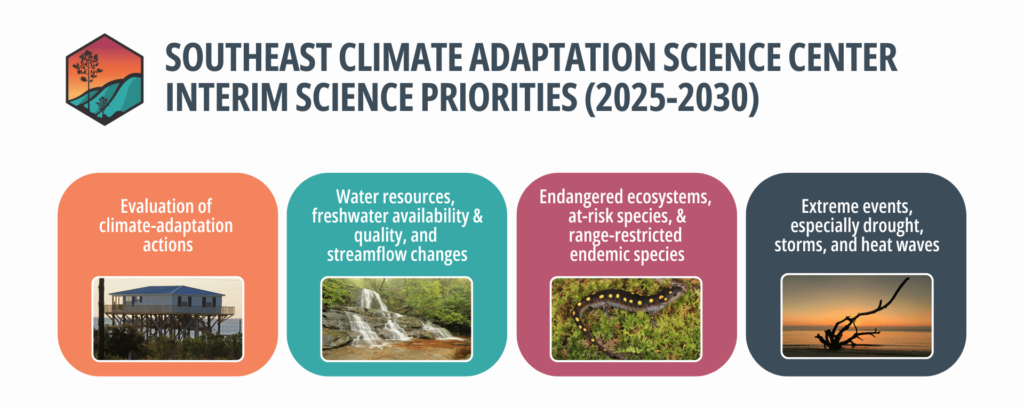Science Priorities (2025-2030)
The below interim priorities guide our projects and collaborations.

Here, we spotlight critical areas of research and collaboration that address pressing adaptation challenges in the Southeast.
Science priorities are regularly evaluated to rapidly adapt to emerging science needs. While the priorities are listed separately for clarity, we acknowledge that they often overlap or interact in practice.
We also include three themes that can be applied to all priorities outlined below.
Themes Across All Priorities
Synthesis and accessibility of information. There is a need to distill complex and sometimes conflicting sources of data and information into user-friendly conclusions for busy and often under-resourced management agencies.
Social science & human dimensions. For a given science priority, what is the role of cultural heritage, economics, budgetary constraints, political and institutional context, and decision-making approaches?
Geographic disparities. Science efforts in Arkansas, Tennessee, non-coastal Alabama and Mississippi, and the U.S. Caribbean are of special concern due to less research funding being allocated to these regions historically.
Use the boxes below to expand and explore each priority:
Evaluation of climate-adaptation actions
- Success rates and cost-effectiveness of alternative adaptation options
- Sub-categories of adaptation actions include: species relocations/translocations, nature-based solutions, protecting climate-change refugia, and (certain cases of) ecosystem restoration
- Application of Resist-Accept-Direct framework
- Structured Decision-making (& similar) to weigh tradeoffs between various options
- Case studies & pilot projects that can be scaled up and/or evaluated for effectiveness
- Databases & data sharing across silos on adaptation efforts (who, when, where, results)
- Institutional context: agencies constrained by time, funding, or politics
- Role of long-term monitoring, leveraging existing efforts (e.g., NPS I&M)
- Long-standing best practices that also have a climate-adaptation benefit
- Potential unintended consequences of certain adaptation efforts
- Consequences and costs of delay or inaction
Water resources, freshwater availability & quality, and streamflow changes
- More extreme high flows, inland flooding impacts on ecosystems & cultural resources
- Seasonal and drought-driven changes in low-flow conditions
- Changes in seasonal timing of high or low flows related to species phenology
- Stream-temperature impacts on sensitive aquatic species
- Climate impacts on water quality (e.g., harmful algal blooms)
- Freshwater sediment & geomorphology (e.g., erosion & sediment pollution from stronger storms)
- Changing freshwater delivery to estuaries (e.g. salinity changes)
Endangered ecosystems, at-risk species, and range-restricted endemic species
- Biodiversity hotspots: ecosystems that support large numbers of rare and endemic species
- Ecosystems and habitats with exceptionally high rates of loss
- Species of Greatest Conservation Need (SGCN)
- Population dynamics, threat assessments, & genetic diversity of at-risk species
- Compounding threats to species, including interactions with many of the bullets below:
- Rare native plants, potential to leverage new Regional SGCN list for plants
- Species of cultural significance (e.g., rivercane)
- Species with very small geographic ranges and/or narrow physiological tolerance ranges
Extreme events: drought, storms, and heat waves
- Drought-triggered ecological transformations
- Drought impacts on fire management
- Proactive vs. reactive drought planning
- Changes in storm frequency, severity, and impact
- Compounding events (e.g., heat waves that coincide with droughts)
- Heat-stress thresholds of sensitive species
- Considering species’ tolerance to extreme events in planning ecological restoration
- Heat-wave impacts on communities
Tribal priorities
- Traditional ecological knowledges
- Tribal sovereignty over data, knowledge, and information
- Ethical engagement between Tribal and non-Tribal institutions
- Importance of investing time to build ongoing relationships
- Cultural sites and resources
- Culturally important plant and animal species, including ancestral foods
- Data gaps related to Tribal lands and waters
